TIL About The Great Boston Molasses Flood Of 1919
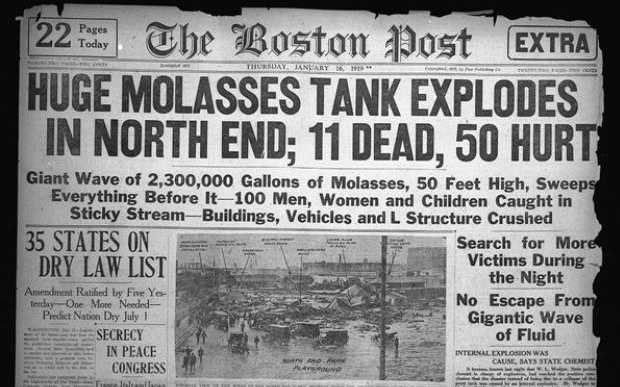
It’s 12:30pm on Wednesday, January 15th 1919 - lunchtime for most workers around 529 Commerical Street in Boston. Some said it sounded like a dull, muffled roar – others said it was a sound like a machine gun rat-a-tat-tat as the rivets shot out! What that noise meant was the 50ft high, 90ft in diameter molasses storage tank had just burst open, sending its 2.3 million gallons of sticky molasses in a 25ft high wave traveling 35mph to destroy anything in its path.
Policeman Frank McManus was at a callbox giving his precinct his daily report when he heard the explosion. He turned around to see what happened and saw the wall of brown liquid hurtling down the street. After taking a moment to register what was happening he got back on the phone and yelled "Send all available rescue vehicles and personnel immediately, there's a wave of molasses coming down Commercial Street!"
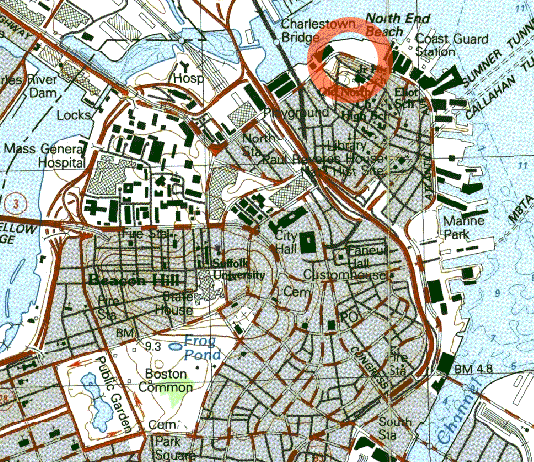
The deluge pushed a railcar into ten year-old Pasquale Iantosca, crushing him. It broke the steel beams holding up the elevated railway and took numerous buildings off their foundations, including nearby firehouse 31, killing one firefighter – George Layhe. The thick wave picked up and carried carts, trucks, people, dogs, horses a great many feet, with any living creature struggling to keep its head above the fluid.
Anthony di Stasio, walking homeward with his sisters from the Michelangelo School, was picked up by the wave and carried, tumbling on its crest, almost as though he were surfing. Then he grounded and the molasses rolled him like a pebble as the wave diminished. He heard his mother call his name and couldn't answer, his throat was so clogged with the smothering goo. He passed out, then opened his eyes to find three of his four sisters staring at him. - Smithsonian 1983
Molasses is a non-Newtonian fluid, that means the viscosity depends on the force applied to it. Due to this, molasses is even more devastating than water. The thick wall of syrup pouring from the exploded tank initially moved fast enough to sweep people up and destroy buildings, only to slow into a more gelatinous state that trapped people.
When the wave finally stopped, the entire area was destroyed.
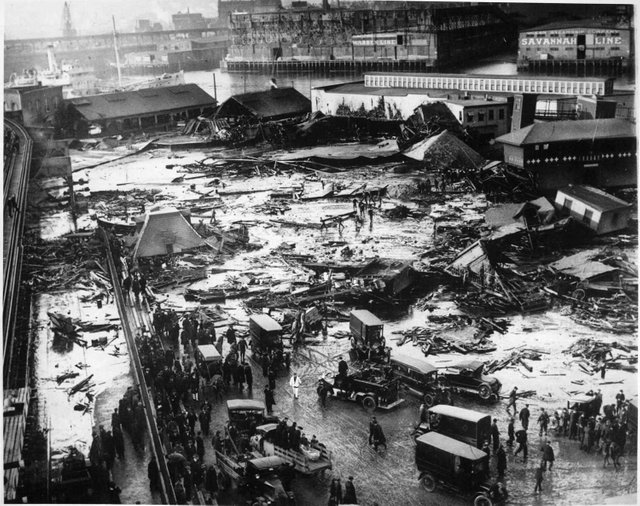
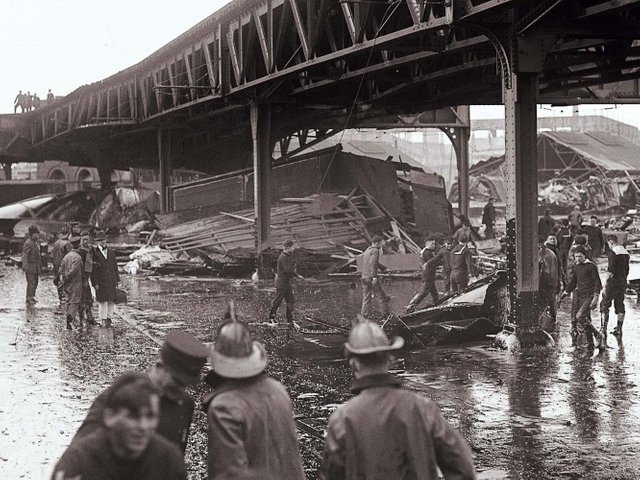
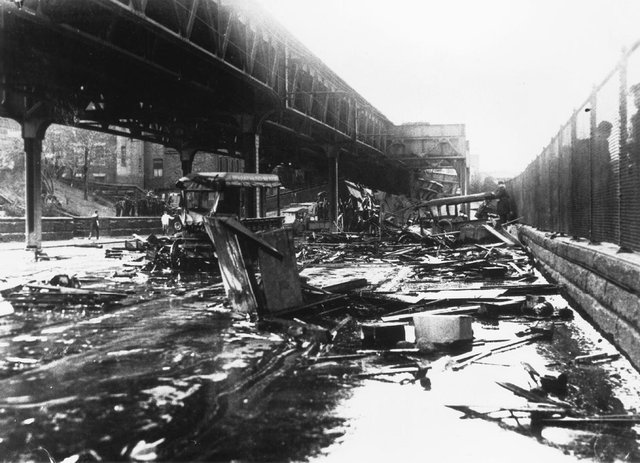
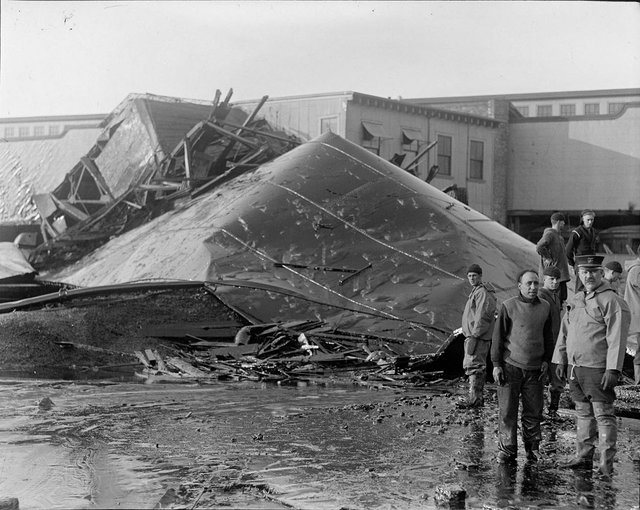
The first responders to the disaster were 116 cadets off the nearby USS Nantucket. They waded into the knee-deep mess to pull out survivors and give first aid. Soon the Boston police, Red Cross, and a military company from an army station arrived on scene.
People and bodies pulled from the molasses looked “as though covered in heavy oil skins ... eyes and ears, mouths and noses filled.” A field hospital was set up a half-mile away in Haymarket. There survivors were brought and staff worked to remove the molasses from their noses and throats so they could breathe. The entire hospital and workers were soon covered in it. Soon it seemed the whole north end was covered in it, anyone who ventured to see the scene for themselves brought the sticky residue back with them on their boots and clothes to end up leaving it wherever they went after. "Everything a Bostonian touched was sticky."
21 people ended up dead, and 150 wounded. The clean-up operation was said to have taken 87,000 man hours. Sea water was pumped to clean up the mess, as regular water was unable to, and it flowed back into the harbor, staining it brown until summer. As the molasses hardened, workers had to chisel and saw it away. The last body was found 4 months later. Inflation adjusted damages exceeded $110,000,000.
It all happened because of cutting corners. The tank was completed just three days before its first molasses shipment was expected – not enough time to fill it with seawater to test out its integrity. As soon as the first molasses went it, it started to slowly seep out. The company’s response was to paint the tank brown to match the color of the leaking molasses. People would fill bottles with the oozing stuff to use back home.
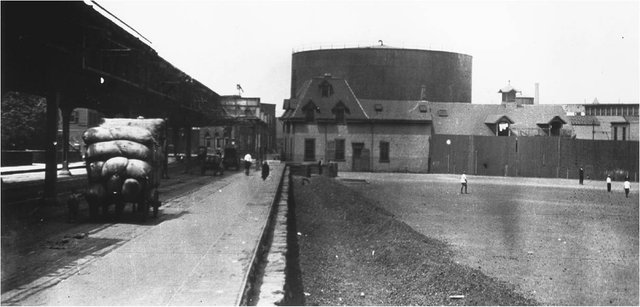
Pieces of the tank were examined at the Massachusetts Institute of Technology shortly after the disaster and it was found to be half as thick as was needed and held together with too few rivets. Additionally, that day was unseasonable warm and possibly some fermentation took place to increase the pressure inside the storage tank. The company that owned the tank, United States Industrial Alcohol, claimed that Italian anarchists sabotaged it and were to blame.
119 separate lawsuits were filed against the company, and it started one of the longest legal cases in the history of the nation up to that time. By 1925 the company saw they had little chance of winning, and settled out of court paying only about $12,000,000 in inflation adjusted damages.
Because of this tragedy the city started to require that all construction plans be approved by an architect or engineer and filed with the city, a requirement that soon became common throughout the country.
Today the site where this occurred is now Langone park, a place of Little League baseball fields and bocce ball courts. Nothing remains in the area that was there in 1919. Only a tiny green plaque set into a wall tells people what happened.
Local residents say that on a hot summer day the sweet molasses smell can still be found in the air.
Sources:
- A Sticky Tragedy: The Boston Molasses Disaster
- The Science of the Great Molasses Flood
- Great Molasses Flood
My moment of honesty:
- My interests vary but I strive for quality work, check my blog for proof.
- I will not fill up your feed with crap, I have only resteemed twice.
- I will also reply to all your comments if they warrant any reply.
- These things I promise to you. So follow me, or don't. I want you to do what you want to.
@getonthetrain
Wow. I saw the headline and was about to post a picture of Homer Simpson saying something funny... but there really is nothing funny about this at all. I had never heard of this before.
I'm from near Boston and I hadn't heard of it either until I ran across it randomly.
One of the sad moments in Boston's history - Uno de los momentos tristes de la historia de Boston
Indeed, a very sad day so long ago.
Wow, bro! That's one seriously screwed up event! Thanks for the heads up about it. The "TIL" tag is made literally made for you, man!
Pretty much, for the most part my stuff has just been long 'TIL'. Thanks for reading @ezzy, and I eagerly await your next post! :D
Whoooaaa. Funny story, I just now learned about this, too. hehe
A little known, but crazy, story of Boston's history.
Thanks for sharing this story. I am always learning things when reading your blog :)
Hey thanks! I learn when I read your posts too :D
This post has been ranked within the top 50 most undervalued posts in the second half of Nov 19. We estimate that this post is undervalued by $6.37 as compared to a scenario in which every voter had an equal say.
See the full rankings and details in The Daily Tribune: Nov 19 - Part II. You can also read about some of our methodology, data analysis and technical details in our initial post.
If you are the author and would prefer not to receive these comments, simply reply "Stop" to this comment.